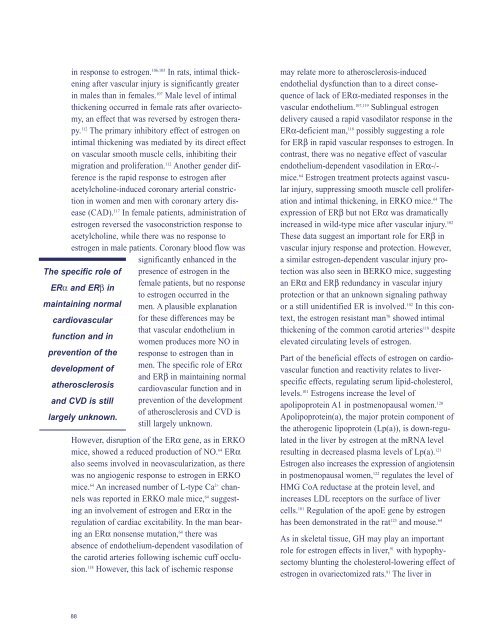WOMEN 'S HEALTH AND MENOPAUSE : - National Heart, Lung ...
WOMEN 'S HEALTH AND MENOPAUSE : - National Heart, Lung ...
WOMEN 'S HEALTH AND MENOPAUSE : - National Heart, Lung ...
Create successful ePaper yourself
Turn your PDF publications into a flip-book with our unique Google optimized e-Paper software.
in response to estrogen. 106,105 In rats, intimal thickening<br />
after vascular injury is significantly greater<br />
in males than in females. 107 Male level of intimal<br />
thickening occurred in female rats after ovariectomy,<br />
an effect that was reversed by estrogen therapy.<br />
112 The primary inhibitory effect of estrogen on<br />
intimal thickening was mediated by its direct effect<br />
on vascular smooth muscle cells, inhibiting their<br />
migration and proliferation. 112 Another gender difference<br />
is the rapid response to estrogen after<br />
acetylcholine-induced coronary arterial constriction<br />
in women and men with coronary artery disease<br />
(CAD). 117 In female patients, administration of<br />
estrogen reversed the vasoconstriction response to<br />
acetylcholine, while there was no response to<br />
estrogen in male patients. Coronary blood flow was<br />
significantly enhanced in the<br />
The specific role of presence of estrogen in the<br />
female patients, but no response<br />
ERα and ERβ in<br />
to estrogen occurred in the<br />
maintaining normal men. A plausible explanation<br />
cardiovascular for these differences may be<br />
that vascular endothelium in<br />
function and in<br />
women produces more NO in<br />
prevention of the response to estrogen than in<br />
development of<br />
men. The specific role of ERα<br />
and ERβ in maintaining normal<br />
atherosclerosis cardiovascular function and in<br />
and CVD is still prevention of the development<br />
of atherosclerosis and CVD is<br />
largely unknown.<br />
still largely unknown.<br />
However, disruption of the ERα gene, as in ERKO<br />
mice, showed a reduced production of NO. 64 ERα<br />
also seems involved in neovascularization, as there<br />
was no angiogenic response to estrogen in ERKO<br />
mice. 64 An increased number of L-type Ca 2+ channels<br />
was reported in ERKO male mice, 64 suggesting<br />
an involvement of estrogen and ERα in the<br />
regulation of cardiac excitability. In the man bearing<br />
an ERα nonsense mutation, 64 there was<br />
absence of endothelium-dependent vasodilation of<br />
the carotid arteries following ischemic cuff occlusion.<br />
118 However, this lack of ischemic response<br />
88<br />
may relate more to atherosclerosis-induced<br />
endothelial dysfunction than to a direct consequence<br />
of lack of ERα-mediated responses in the<br />
vascular endothelium. 107,119 Sublingual estrogen<br />
delivery caused a rapid vasodilator response in the<br />
ERα-deficient man, 118 possibly suggesting a role<br />
for ERβ in rapid vascular responses to estrogen. In<br />
contrast, there was no negative effect of vascular<br />
endothelium-dependent vasodilation in ERα-/mice.<br />
64 Estrogen treatment protects against vascular<br />
injury, suppressing smooth muscle cell proliferation<br />
and intimal thickening, in ERKO mice. 64 The<br />
expression of ERβ but not ERα was dramatically<br />
increased in wild-type mice after vascular injury. 102<br />
These data suggest an important role for ERβ in<br />
vascular injury response and protection. However,<br />
a similar estrogen-dependent vascular injury protection<br />
was also seen in BERKO mice, suggesting<br />
an ERα and ERβ redundancy in vascular injury<br />
protection or that an unknown signaling pathway<br />
or a still unidentified ER is involved. 102 In this context,<br />
the estrogen resistant man 70 showed intimal<br />
thickening of the common carotid arteries 118 despite<br />
elevated circulating levels of estrogen.<br />
Part of the beneficial effects of estrogen on cardiovascular<br />
function and reactivity relates to liverspecific<br />
effects, regulating serum lipid-cholesterol,<br />
levels. 101 Estrogens increase the level of<br />
apolipoprotein A1 in postmenopausal women. 120<br />
Apolipoprotein(a), the major protein component of<br />
the atherogenic lipoprotein (Lp(a)), is down-regulated<br />
in the liver by estrogen at the mRNA level<br />
resulting in decreased plasma levels of Lp(a). 121<br />
Estrogen also increases the expression of angiotensin<br />
in postmenopausal women, 122 regulates the level of<br />
HMG CoA reductase at the protein level, and<br />
increases LDL receptors on the surface of liver<br />
cells. 101 Regulation of the apoE gene by estrogen<br />
has been demonstrated in the rat 123 and mouse. 64<br />
As in skeletal tissue, GH may play an important<br />
role for estrogen effects in liver, 91 with hypophysectomy<br />
blunting the cholesterol-lowering effect of<br />
estrogen in ovariectomized rats. 91 The liver in
















